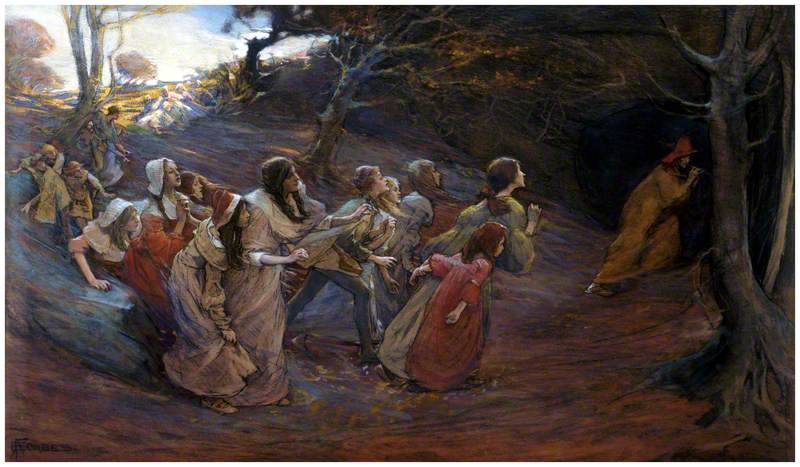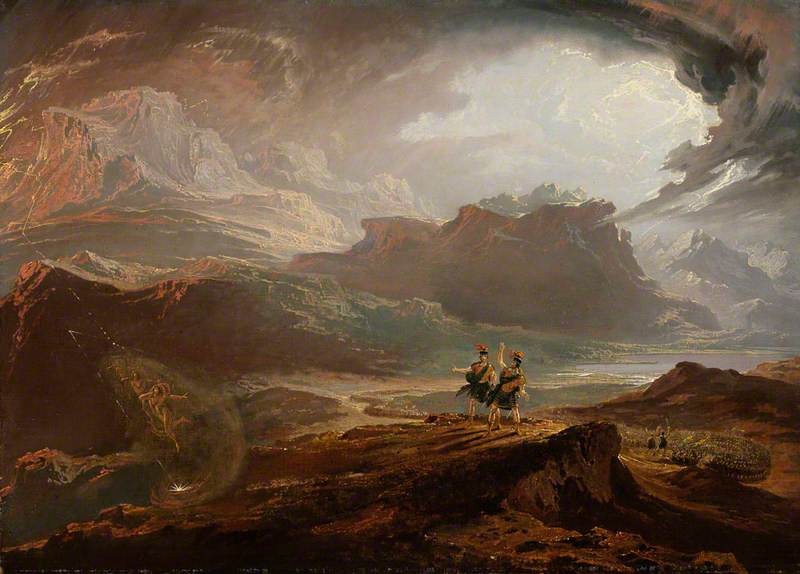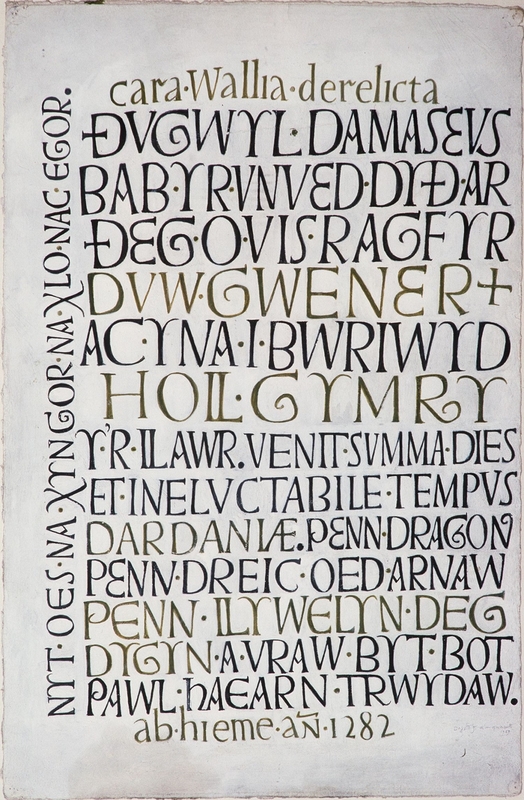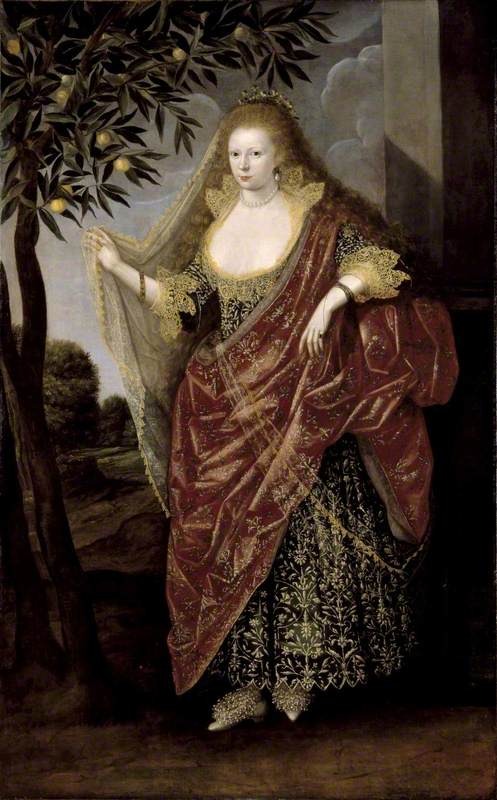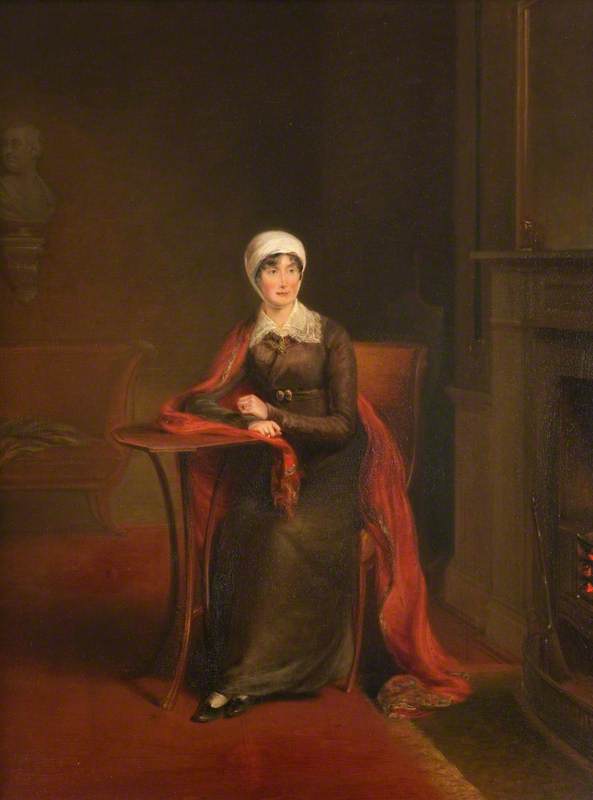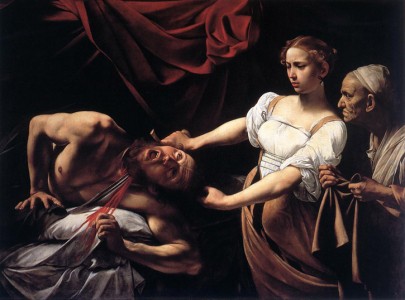A legend is a story that contains – or is or was believed to contain – a grain of truth. Many legends have sprung up around people who really lived: queens, outlaws, knights, pirates, acrobats and saints among them. If a lord was cruel, a neighbour strange or a counsellor wise, whispers would follow them. Translated by legend, they become goodies and baddies, magicians and outlaws, witches and warriors familiar to us all – and often these figures provide inspiration for artists and sculptors, as well as storytellers.

Image credit: Parliamentary Art Collection
The Legend of King Arthur: Arthur Crowned King
Henry Hugh Armstead (1828–1905)
Parliamentary Art CollectionWhile I gathered legendary poems for a new anthology, Heroes and Villains, I loved researching the strange, enduring tales, and looking at the ways in which artists over the centuries had interpreted them. Here are some of my favourite heroes and villains from the UK's art collections.
Robin Hood
Robin wends his merry way from medieval English ballads all the way to Hollywood and universal fame. Various elements are stitched onto his stories over the centuries (Marian is a late innovation, for example, but Much the Miller's Son features in his earliest appearances). Theories abound as to whether Robin is based on a real figure, but whatever the root of his stories, his band of outlaws in Sherwood Forest have captured the imagination of artists and writers for hundreds of years.

© the copyright holder. Image credit: Kevin Gavaghan / Art UK
Robin Hood and Little John 1952
James Arthur Woodford (1893–1976)
Castle Road, Nottingham, NottinghamshireThese bronze panels by James Arthur Woodford from the 1950s run along the castle wall behind Nottingham's Robin Hood statue – I love the depiction of Robin and Little John fighting with staves.
Boadicea or Boudicca
Queen of the ancient British tribe of the Iceni, Boudicca led a valiant but unsuccessful uprising against the invading Roman forces in AD 60 or 61. Her armies laid waste to Londinium, Camulodunum (modern Colchester) and Verulamium (close to St Albans), but eventually fell to the Roman legions led by Suetonius – and the era of Roman Britain dawned.
This wild painting by Charles Gogin, bristling with spears, immortalises the clash.
The Pied Piper
The tale of the mysterious musician who rids a town of its rats, goes unpaid and, in revenge, leads the town's children away is known to countless young readers. It has passed through many hands, including those of the Brothers Grimm and Robert Browning, whose famous poem tells us that:
'… out of the houses the rats came tumbling.
Great rats, small rats, lean rats, brawny rats,
Brown rats, black rats, grey rats, tawny rats,
Grave old plodders, gay young friskers,
Fathers, mothers, uncles, cousins,
Cocking tails and pricking whiskers…'
It seems the piper may have his roots in reality. In Hamelin, in Bavaria, a plaque on a house dating to 1602 – and an even older one on the building's window – reads: 'AD 1284 – on the 26th of June – the day of St John and St Paul – 130 children – born in Hamelin – were led out of the town by a piper wearing multicoloured clothes. After passing the Calvary near the Koppenberg they disappeared forever.'
Theories include economic migration, with brightly dressed recruiters attracting young people to move, the impact of the devastating Black Death, the thirteenth-century 'Children's Crusade' to the Holy Land or even an instance of the 'dancing plague' which caused its feverish victims to cavort and caper before they dropped. It's impossible to know what the true story might have been, but the Pied Piper's fame is undimmed.
There's so much movement in this eerie, atmospheric painting by Elizabeth Adela Forbes, showing the children as they dance out of town.
Robinson Crusoe
Daniel Defoe's 1719 novel was inspired by the true story of hotheaded Alexander Selkirk, a Scottish sailor who was marooned on a desert island off the coast of Chile for over four years after falling out with his captain. He lived on goats and crayfish, tamed feral cats to rid himself of vermin and sang psalms to keep his spirits up. He became a celebrity after his rescue, telling his amazing story in pubs for the price of a pint and a meal, but Defoe's novel ensured his legend endured.

© the copyright holder. Image credit: Paul Francis / Art UK
Castaway (Alexander Selkirk, 1676–1721) 2019
Frank Benson (b.1976)
Clifton Hill, Bristol City, BristolI love this bronze statue – Castaway by Frank Benson – in Bristol.
Joan of Arc
The history of the teenage peasant girl who led French forces to several resounding victories during the Hundred Years War is as extraordinary as any fiction. Eventually handed over to the English, she was burnt at the stake as a heretic, but later canonised and elevated to heroic status in France.
Her incredible story has long inspired artists and writers. My favourite is this glamorous Rossetti painting in The Fitzwilliam Museum.
Alfred the Great
The Saxon king who dreamed of a united England, Alfred features in many stories – being blessed by the Pope in Rome as a child, his time evading the Vikings in the marshlands of the Somerset levels and – of course – burning a peasant woman's cakes being among these.
This splendid bust originally graced the facade of an insurance company on Exeter High Street – Alfred was their logo. The building was destroyed in a German bombing raid in 1942, but this head was saved. It can be seen in the Royal Albert Memorial Museum & Art Gallery in Exeter.
Saint Francis
The brown-robed Italian mystic and friar who founded the Franciscan order is one of the most recognisable figures in art history. Born in the late twelfth century, Francis was a worldly youth who renounced his wealthy family and devoted himself to rebuilding ruined chapels around Assisi and tending to the poor and sick. Many stories connect him to animals and the natural world, including the legend of him taming the wild wolf of Gubbio and – a favourite subject for artists – preaching to the birds.
This agonised painting of the saint by Crivelli is in The National Gallery.
Macbeth
Known as the Red King, Macbeth was king of Scotland from 1040 until his death in 1057. Although Shakespeare has him and his wicked wife slaying King Duncan in his sleep, the historical Macbeth's troops killed Duncan in battle. Macbeth himself died on the battlefield after a relatively peaceful reign, and he was buried on the Isle of Iona. Shakespeare's chief source was the entertaining but inaccurate Holinshed's Chronicles, published in the late sixteenth century.
This dramatic painting by John Martin illustrates Macbeth's legend.
Ana Sampson, author
Ana Sampson is the editor of poetry anthologies including Heroes and Villains, illustrated by Chris Riddell. You can sign up for Ana's newsletter on her website.


